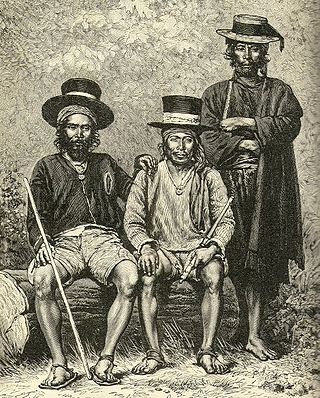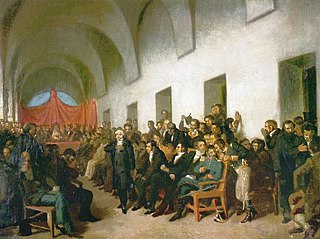Related Research Articles

Campeche is a state on the Yucatán Peninsula in Mexico that is divided into thirteen municipalities. According to the 2020 Mexican census, Campeche is the third least populous state with 928,363 inhabitants and the 17th largest by land area spanning 57,693.59 square kilometres (22,275.62 sq mi).

Alcalde is the traditional Spanish municipal magistrate, who had both judicial and administrative functions. An alcalde was, in the absence of a corregidor, the presiding officer of the Castilian cabildo and judge of first instance of a town. Alcaldes were elected annually, without the right to reelection for two or three years, by the regidores of the municipal council. The office of the alcalde was signified by a staff of office, which they were to take with them when doing their business. A woman who holds the office is termed an Alcaldesa.

Colima is a state in West Mexico that is divided into ten municipalities. According to the 2020 Mexican census, it has the smallest population of all Mexico's states with 731,391 inhabitants, and is the fifth smallest by land area spanning 5,801.75 square kilometres (2,240.07 sq mi).
Ayuntamiento is the general term for the town council, or cabildo, of a municipality or, sometimes, as is often the case in Spain and Latin America, for the municipality itself. Ayuntamiento is mainly used in Spain; in Latin America alcaldía is also for municipal governing bodies, especially the executive ones, where the legislative body and the executive body are two separate entities. In Catalan-speaking parts of Spain, municipalities generally use the Catalan cognate, ajuntament, while Galician ones use the word concello, Astur-Leonese conceyu and Basque udaletxea. Since ayuntamiento is a metonym for the building in which the council meets, it also translates to "city/town hall" in English.

San Nicolás de los Garza, sometimes known only as San Nicolás, is a city and coextensive municipality in the Mexican state of Nuevo León that is part of the Monterrey metropolitan area. It has become primarily a city for residences and family houses, although it still has several factories that tend to relocate to the periphery of the metropolitan area. It is the fifth-largest city in the state, behind Monterrey, Guadalupe, Ciudad Apodaca and General Escobedo.

Municipalities are the second-level administrative divisions of Mexico, where the first-level administrative division is the state. They should not be confused with cities or towns that may share the same name as they are distinct entities and do not share geographical boundaries. As of January 2021, there are 2,454 municipalities in Mexico, excluding the 16 boroughs of Mexico City. If all 16 boroughs of Mexico City are counted, the total of municipalities will be 2,470.

Ciudad Benito Juárez, or simply Juárez, is the name of a city located in the eastern part of the Monterrey metropolitan area in the state of Nuevo León, Mexico. It is the seat of the municipality of the same name. Ciudad Benito Juárez had a 2020 census population of 308,285 and is the sixth-largest city in Nuevo León. It shares borders with the municipalities of Pesquería to the north; to the south with Santiago; to the east with Cadereyta Jiménez; and to the west with Guadalupe.

Corregidora is a Mexican municipality in the southwest of the state Querétaro, on the border with Guanajuato. Its municipal seat is the town of El Pueblito, which had a population of 44,305 in the 2005 census.

The municipalities or municipios of El Salvador correspond to the second level administrative division in the Republic of El Salvador which divide its departments. El Salvador contains 262 municipalities.

A cabildo or ayuntamiento was a Spanish colonial and early postcolonial administrative council that governed a municipality. Cabildos were sometimes appointed, sometimes elected, but were considered to be representative of all land-owning heads of household (vecinos). The colonial cabildo was essentially the same as the one that was developed in medieval Castile.
A corregidor was a local administrative and judicial official in Spanish Empire. They were the representatives of the royal jurisdiction over a town and its district.
Sargento mayor was a rank immediately below that of maestre de campo in the Spanish tercios of the 16th and 17th centuries. Initially second in rank to a coronel ("colonel") in a colunella, the sargento mayor became second in rank to the maestre de campo after the creation of the tercios in 1534. He took care of the tactical training, security and lodging of the troops of the tercio. He also transmitted the orders of the maestre de campo or the capitán general to subordinate officers.

The Mayor of Pichilemu is an elected politician who is the head of the executive branch of government of the commune of Pichilemu, Libertador General Bernardo O'Higgins Region, Chile. The mayor presides over the local city council, composed of six members, and serves as the civic representative of the commune. The mayor is popularly elected in a municipal election, by simple majority. The office is held for a four-year term without term limits.
Síndico Procurador was a Spanish term for a colonial city attorney or municipal corporation counsel used in the former Viceroyalty of New Spain based in Spanish colonial México. It was used to identify the local administrative and judicial position within a town council, corresponding to a present-day city attorney or corporation counsel.
Alcalde ordinario refers to the judicial and administrative officials in the cabildos in the Spanish Viceroyalties in the Americas during the times of the Spanish Empire in the 16th through 19th centuries. Always existing in pairs, they were called Alcalde de primer voto and Alcalde de segundo voto. The alcalde ordinario was a judicial magistrate who, with some exceptions, was responsible for the administration of civil and criminal justice within their municipal jurisdiction.
An alcalde mayor was a regional magistrate in Spain and its territories from, at least, the 14th century to the 19th century. These regional officials had judicial, administrative, military and legislative authority. Their judicial and administrative functions superseded those of an alcalde. Their area of territorial jurisdiction was called an alcaldía mayor. Judicial appeals from the decisions of an alcalde mayor were heard by an audiencia.
Teniente a guerra was a title used in times of the Spanish colonial Empire to describe a position exercising duties similar to those exercised by a town or city mayor today (2019). A teniente a guerra was a position that combined the duties of mayor, military lieutenant and justice of the peace.
Alcalde de la Santa Hermandad was a term used in the Spanish colonies in the Americas during the times of the Spanish Empire. The term referred to judicial magistrates named in towns and villages within the jurisdiction of the Spanish Empire in the Americas whose function was primarily to be informed of infractions committed in rural areas against the established order, so they could be prosecuted. In this capacity, their primary function was to help the militia of a rural region within the jurisdiction of a cabildo. This militia was organized under an institution termed Santa Hermandad. The term of service of an Alcalde de la Santa Hermandad was one year. The position was eliminated around 1835, when the Santa Hermandad force itself was disestablished.

The Ayuntamiento de Granada is the institution charged with the government and administration of the Spanish municipality of Granada.
References
- 1 2 González, Eloísa. Sánchez, Gabriela (ed.). "¿Qué es el municipio?". Movimiento Ciudadano por la Democracia (in Spanish). La Neta SC. Archived from the original on 14 January 2007. Retrieved 26 May 2019.
- ↑ Zumaya Ojeda, Oscar. "Regidor del XVIII Ayuntamiento de Tijuana". C.P.Oscar Zumaya Ojeda (in Spanish). Archived from the original on 30 October 2005. Retrieved 26 May 2019.
- ↑ "Título II (1). Régimen de Gobierno (ART. 25 AL 51)". Universidad Nacional Autónoma de México (in Spanish). Archived from the original on 10 December 2004. Retrieved 26 May 2019.